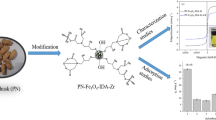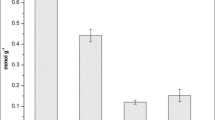Abstract
A novel adsorbent (FB-mZVI ) was prepared, using tailings from iron ore concentration plants, fly ash and bentonite, to remove crystal violet (CV) and methylene blue (MB) from polluted water . The adsorbent was prepared as cylindrical-shape pellets to easily separate it from the water after the adsorption process. The statistical orthogonal method was used to evaluate the factors determining the synthesis of FB-mZVI. Batch experiments revealed that the optimum mass ratio of fly ash, bentonite, iron ore tailings and palm kernel shell was 2:2:1:1. And in the synthesis of FB-mZVI adsorbent, the optimum reaction temperature was 800 °C, the reaction time was 10 min and the heating rate was 10 °C/min. SEM Characterization revealed that the adsorbent was highly porous and constituted by Fe0 particles finely dispersed on an aluminosilicate matrix. The adsorbent showed to have a superior adsorption capacity for CV and MB when compared to other conventional adsorbents. The adsorption kinetics and isotherms of CV and MB on FB-mZVI adsorbents could be expressed by the pseudo-second-order model and Langmuir isotherm.
Similar content being viewed by others
References
Fan, Y., Liu, H. J., Zhang, Y., & Chen, Y. (2015). Adsorption of anionic MO or cationic MB from MO/MB mixture using polyacrylonitrile fiber hydrothermally treated with hyperbranched polyethylenimine. Journal of Hazardous Materials, 283, 321–328.
Phetphaisit, C. W., Yuanyang, S., & Chaiyasith, W. C. (2016). Polyacrylamido-2-methyl-1-propane sulfonic acid-grafted-natural rubber as bio-adsorbent for heavy metal removal from aqueous standard solution and industrial wastewater. Journal of Hazardous Materials, 301, 163–171.
Cottet, L., Almeida, C. A. P., Naidek, N., Viante, M. F., Lopes, M. C., & Debacher, N. A. (2014). Adsorption characteristics of montmorillonite clay modified with iron oxide with respect to methylene blue in aqueous media. Applied Clay Science, 95, 25–31.
Rasalingam, S., Peng, R., & Koodali, R. T. (2015). An insight into the adsorption and photocatalytic degradation of rhodamine B in periodic mesoporous materials. Applied Catalysis, B: Environmental, 174, 49–59.
Gao, Y. W., Guo, Y. Z., & Zhang, H. (2016). Iron modified bentonite: Enhanced adsorption performance for organic pollutant and its regeneration by heterogeneous visible light photo-fenton process at circumneutral pH. Journal of Hazardous Materials, 302, 105–113.
Soon, A. N., & Hameed, B. H. (2013). Degradation of acid blue 29 in visible light radiation using iron modified mesoporous silica as heterogeneous photo-fenton catalyst. Applied Catalysis, A: General, 450, 96–105.
Patra, A. S., Ghorai, S., Ghosh, S., Mandal, B., & Pal, S. (2016). Selective removal of toxic anionic dyes using a novel nanocomposite derived from cationically modified guar gum and silica nanoparticles. Journal of Hazardous Materials, 301, 127–136.
Cho, D. W., Chon, C. M., Kim, Y., Jeon, B. H., Schwartz, F. W., Lee, E. S., et al. (2011). Adsorption of nitrate and Cr(VI) by cationic polymer-modified granular activated carbon. Chemical Engineering Journal, 175, 298–305.
Osinubi, K. J., Yohanna, P., & Eberemu, A. O. (2015). Cement modification of tropical black clay using iron ore tailings as admixture. Transportation Geotechnics, 5, 35–49.
Shettima, A. U., Hussin, M. W., Ahmad, Y., & Mirza, J. (2016). Evaluation of iron ore tailings as replacement for fine aggregate in concrete. Construction and Building Materials, 120, 72–79.
Zheng, J., Gao, Z., He, H., Yang, S., & Sun, C. (2016). Efficient degradation of acid orange 7 in aqueous solution by iron ore tailing fenton-like process. Chemosphere, 150, 40–48.
Wang, J. Q., Liu, Y. H., Chen, M. W., Xie, G. Q., Louzguine-Luzgin, D. V., Inoue, A., et al. (2012). Rapid degradation of azo dye by Fe-based metallic glass powder. Advanced Functional Materials. doi:10.1002/adfm.201103015
Zhang, C., Zhang, H., Lv, M., & Hu, Z. (2010). Decolorization of azo dye solution by Fe-Mo-Si-B amorphous alloy. Journal of Non-Crystalline Solids, 356, 1703–1706.
Kerkez, D. V., Tomašević, D. D., Kozma, G., Bečelić-Tomin, M. R., Prica, M. D., Rončević, S. D., et al. (2014). Three different clay-supported nanoscale zero-valent iron materials for industrial azo dye degradation: A comparative study. Journal of the Taiwan Institute of Chemical Engineers. http://dx.doi.org/10.1016/j.jtice.2014.04.019
Guz, L., Curutchet, G., Torres, R. M., Sánchez, & Candal, R. (2014). Adsorption of crystal violet on montmorillonite (or iron modified montmorillonite) followed by degradation through fenton or photo-fenton type reactions. Journal of Environmental Chemical Engineering, 2, 2344–2351.
Wang, W., Cheng, Y., Kong, T., & Cheng, G. (2015). Iron nanoparticles decoration onto three-dimensional graphene for rapid and efficient degradation of azo dye. Journal of Hazardous Materials, 299, 50–58.
Rashid, R. Z. A., Salleh, H. M., Ani, M. H., Yunus, N. A., Akiyama, T., & Purwanto, H. (2014). Reduction of low grade iron ore pellet using palm kernel shell. Renewable Energy, 63, 617–623.
El-Hussiny, N. A., & Shalabi, M. E. H. (2011). A self-reduced intermediate product from iron and steel plants waste materials using a briquetting process. Powder Technology, 205, 217–223.
Mohsenzadeh, M. S., & Mazinani, M. (2016). On the yield point phenomenon in low-carbon steels with ferrite-cementite microstructure. Materials Science and Engineering A, 673, 193–203.
Shi, L. N., Zhang, X., & Chen, Z. L. (2011). Removal of chromium (VI) from wastewater using bentonite-supported nanoscale zero-valent iron. Water Research, 45, 886–892.
El Hajjouji, H., Ait Baddi, G., Yaacoubi, A., Hamdi, H., Winterton, P., Revel, J. C., et al. (2008). Optimisation of biodegradation conditions for the treatment of olive mill wastewater. Bioresource technology, 99, 5505–5510.
Guo, D., Zhu, L., Guo, S., Cui, B., Luo, S., Laghari, M., et al. (2016). Direct reduction of oxidized iron ore pellets using biomass syngas as the reducer. Fuel Processing Technology, 148, 276–281.
Ponder, S. M., Darab, J. G., & Mallouk, T. E. (2000). Remediation of Cr(VI) and Pb (II) aqueous solutions using supported, nanoscale zero-valent iron. Environmental Science and Technology, 4, 2564–2569.
Chen, Z., Wang, T., Jin, X., Chen, Z., Megharaj, M., & Naidu, R. (2013). Multifunctional kaolinite-supported nanoscale zero-valent iron used for the adsorption and degradation of crystal violet in aqueous solution. Journal of Colloid and Interface Science, 398, 59–66.
Frost, R. L., Xi, Y., & He, H. (2010). Synthesis, characterization of palygorskite supported zero-valent iron and its application for methylene blue adsorption. Journal of Colloid and Interface Science, 341, 153–161.
Acknowledgements
This work was supported by the State Key Laboratory of Environmental Criteria and Risk Assessment (No. SKLECRA2013FP12) and the Public science and technology research funds projects of ocean, China (201105020). The authors would like to thank the anonymous reviewers for their recommendations and comments. Also, Y. Wang would like to thank the State Scholarship Fund organized by the China Scholarship Council for offering her the scholarship during her joint Ph.D. studying in Mexico.
Author information
Authors and Affiliations
Corresponding author
Editor information
Editors and Affiliations
Rights and permissions
Copyright information
© 2017 The Minerals, Metals & Materials Society
About this paper
Cite this paper
Wang, Y., López-Valdivieso, A., Zhang, T., Mwamulima, T., Peng, C. (2017). Novel Adsorbent from Iron Ore Concentration Tailings for Toxic Cationic Dye Removal from Water. In: Meyers, M., et al. Proceedings of the 3rd Pan American Materials Congress. The Minerals, Metals & Materials Series. Springer, Cham. https://doi.org/10.1007/978-3-319-52132-9_57
Download citation
DOI: https://doi.org/10.1007/978-3-319-52132-9_57
Published:
Publisher Name: Springer, Cham
Print ISBN: 978-3-319-52131-2
Online ISBN: 978-3-319-52132-9
eBook Packages: Chemistry and Materials ScienceChemistry and Material Science (R0)




